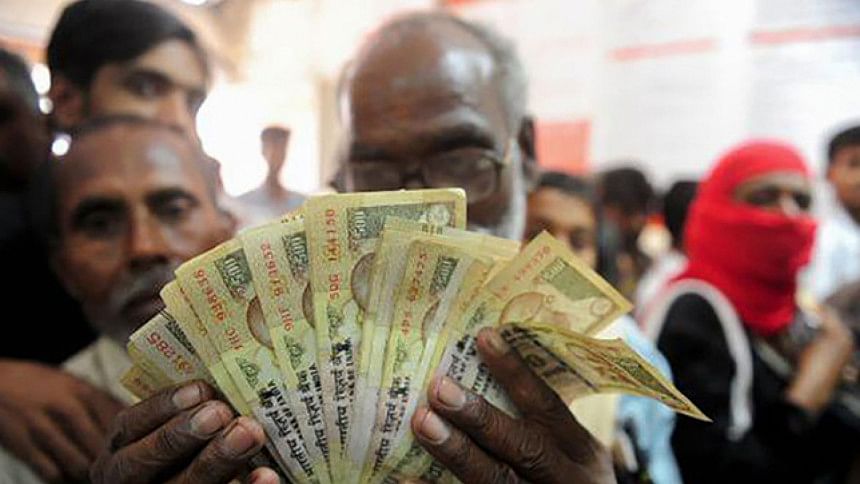Demonetisation: A Noteworthy Modification

My wife and I spent the past week in India, hawking Rs.500 and 1000 notes for whatever discounted price was on offer. If not for the luxury of credit cards, we would have been in trouble. Only a day before our arrival, Narendra Modi's government had suddenly declared the two banknotes void. No banks, shops or restaurants would take them. Banks would not change them for tourists. The only option was to chat up taxi drivers or desi shopkeepers and convince them to buy at a discount our defunct banknotes.
But for tourists, these are mere anecdotes. Indian citizens seemed at a complete loss. Suddenly, neither the poor nor the rich had any paper currency for basic necessities. And this in a predominantly cash economy! Malls were desolate and restaurants quiet. It seemed everyone had gone to queue up in front of banks.
"I have enough money, but none at hand to buy milk for my children," a middle-aged man told us. It wasn't possible for him to take time off work every day and withdraw newly-issued currency every day. Besides, his chances of actually getting (the yet unseen) new notes were slim. There simply wasn't enough to go around.
It became a common sight to see altercations and scuffles break out in front of banks. Sometimes, security guards endured a few blows. Offenders were sent to the back of snaking queues. In time, we would read that nearly fifty people allegedly died from standing in queues and from being refused emergency services in exchange for the old notes.
But these are mere inconveniences, the Modi Government insists. These are essential sacrifices to help India better tackle corruption and black money. It will also hit terror networks and other subversive elements, leaders say. It was a necessary, overdue crusade.
This framing is important: it is not an economic or financial campaign, but a moral one. A fight between Good and Evil. The manifest villain is 'black money' and its hoarders; the protagonist, a fearless and impartial ruling party. That the term 'black money' drowned out any mention of 'untaxed incomes' may also have been a deliberate choice. 'Black money' has an inherent illicit ring to it. Attempts to portray demonetisation as a moral battle was also underscored by the fact that it came into effect through a rousing speech by PM Modi, and not through any central bank gazettes. In the speech, the PM invoked electoral pledges and painted the decision as a natural progression in the fight against corruption and in nation building.
More drama ensued as mere hours were allowed before the banknotes would cease to be legal tender. It quickened the pace; heightened the drama. No gradual reform could have jolted a country like this (Philippines allowed one year for swapping defunct currency in 2015). Reminiscent of Modi's campaigning days, the move was decisive; the tone, authoritative. As a result, the demonetisation drive has come to be seen as a Modi-masterstroke, rather than a monetary policy from the administration. But as journalist P. Sainath notes, "If there's been any stroke, it's the one the heart of the rural economy has suffered."
The central government tacitly acknowledges that (sudden) demonetisation can be unpopular with and difficult for the masses. Even after the country's Supreme Court likened its 'surgical strikes' against black money hoarders to 'carpet bombing' on common people, the administration insisted that the changeup was temporary, necessary and effective.
Many media outlets, commentators and celebrities have acted as though supporting the demonetisation drive is the same as supporting the Modi government, and vice versa. Yoga guru Baba Ramdev has been insisting that people queuing up in front of banks and ATMs were sent by opposition parties, to undermine the ruling BJP. Others in the government have claimed that the move actually aimed at the subversive Pakistan, which was printing more INR than it prints Pakistani currency. Celebrity cricketers have thrown their weight behind the PM, arguing that it was a massive googly bowled by Modi. The PR machinery is clearly working faster than the printing presses of Nashik.
India's sudden-death demonetisation resembles a gamble: it will either be a big win or a catastrophic fail. Perhaps it is this realisation that keeps the administration squarely in the PM's corner. But as Bangladeshis know all too well, governments' marketing slogans for unpopular interventions and facts from the ground are often very different. Despite speeches about punishing illegal and/or corrupt businesses, it is the poor who have suffered.
You see, money has two important functions: it is (a) a store of value and (b) a medium of exchange. With demonetisation, stored value is removed from voided banknotes (to bank balances, credit, new currency); with time, this value may be recovered, more so by those who have access to banking services. But demonetisation also means that mediums of exchange and trade are cancelled. The latest drive in India has rendered nearly 90 percent of all cash useless. Naturally, the same level of production, commerce and consumption is impossible with only 10 percent of cash in circulation.
So why would a government do this? The logic behind demonetisation is oversimplified: if all citizens and businesses can be made to trade old notes for new ones, every rupee in the country will have to pass through the formal economy. Thus, this money will enter into the income-tax radar, and thus be whitened. The process will eliminate black money and earn massive tax revenues for the state.
It's literally a cry of "show me the money!"
However, this line of reasoning ignores a number of key facts. First, there is no real evidence to suggest that overnight demonetisation substantially roots out black money hoards. From the Soviet Union to Ghana to Myanmar – attempts have resulted in hardship for the poor and contempt for governments.
Second, as Kavita Rao of India's National Institute of Public Finance and Policy (NIPFP) points out, Modi's intended targets frequently hoard their wealth in bullion, shares, property (by proxy) and foreign currency. Not rupee notes. As such, scrapping banknotes, for them, is but a minor disruption.
Third, in cash-based economies like India, cash is used by millions of farmers, fishermen, factory-workers, small traders and labourers. For them, dealing in cash is not a means of tax-evasion, but a way of life in the absence of formal banking services and alternative modes of payment. Their intention is not to hoard, but circulate cash for sustenance. Yet, these people – who constitute and sustain the massive informal economy – stand to lose the most.
An interesting case in this regard is that of the battawalas, informal lenders who accept future receivables (e.g. post-dated cheques) and pay 80 or 85 percent of the amount in instant cash. With little access to banks and no credit-ratings, small traders and vendors regularly finance their working capital through battawalas. Now, with some 86 percent of the cash currency scrapped, battawalas have no way to lend and small traders-vendors are rendered incapable of stocking up. Add to this diminishing consumption and you will see how sudden demonetisation is hurting small traders.
Yes, the sudden inflow of cash will swell bank deposits and lower interest rates in the short term. Yes, tax revenues will rise, and inflation may be curbed too. But with that production and consumption could decrease as well. The massive Howrah fish market is about to shut down because suppliers' payments have become impossible. This means fish supply to nearby cities and even Bangladesh will be significantly disrupted. Elsewhere, kharif farmers are failing to finance harvest or transportation, winter farmers are unable to purchase seeds and inputs. Manipur stopped publishing its dozen or so newspapers since distributors just did not have enough legal tenders.
Baidurya Chakrabarti argues that the intention behind Modi's demonetisation was to "de-liquidate cash flow and then assume control over re-liquidation of it." In short, it attempted to hold the vast cash-based economy hostage. But to do so without any regard for farmers, labourers or small businesses is to ignore their vulnerabilities. In certain parts of India, defunct notes are still in defiant circulation, going for slightly discounted prices. In Hyderabad, some bank officials have decided to reintroduce into the local economy old, torn notes meant for destruction. In Orissa, bartering has seen a rebirth: rice has become the staple currency. In face of unprecedented adversity, India's informal sector is responding with patience and creativity. Yet one fears that during this prolonged assault, their resilience will be tested to the limit.
The writer is a strategy and communications consultant.

 For all latest news, follow The Daily Star's Google News channel.
For all latest news, follow The Daily Star's Google News channel. 



Comments